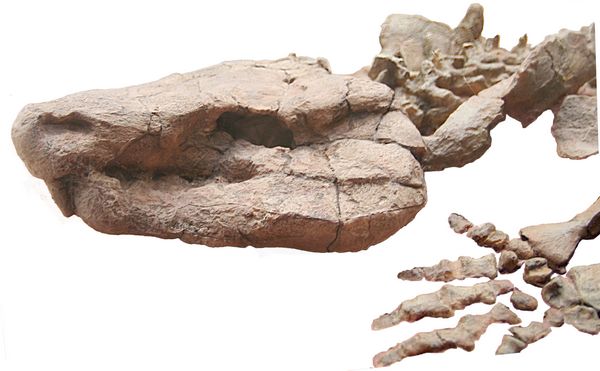Athena Review Image Archive ™
Limnoscelis paludis skull and hand

Skull and hand of Limnoscelis paludis (YPM; photo: Athena Review)
Limnoscelis paludis was a large reptilomorph amphibian, dating from the Late Pennsylvanian and Early Permian periods (310-280 mya). The name means "marsh-footed swamp [dweller]". It belongs to the class Amphibia, the order reptilomorpha, and the suborder Diadectamorph.
The type species was found by Samuel Williston in 1911 in El Cobre Canyon in the Cutler Formation of New Mexico. The holotype (YPM 809, 811, at the Yale Peabody Museum) consists of a skull and partial skeleton.
Limnoscelis was a large carnivorous amphibian in the general grouping called reptilomorphs, which were ancestral to reptiles. The suborder Diadectamorph includes reptile-like amphibians related to Diadectes. The body length of Limnocelis was 1.5 m. Its arms and hands showed the primitive tetrapod traits of humerus, radius, ulna, and five digits. The digits lacked claws. The ankle bones, meanwhile, were fused as in other reptile-like amphibians. This would not allow them to use their feet actively in traction.
The skull of Limnoscelis
had a
deep premaxilla with robust premaxillary fangs. The maxilla or
upper jaw was deeper, with short teeth. The eye orbit was
relatively
smaller than in the related taxa Oedaleops, but in most other respects, the skulls were similar.
References:
Williston S.W. 1911. A new family of reptiles from the Permian of New Mexico: American Journal of Science; Series 4, 31:378-398.
Romer A.S. 1946.
Berman, Reisz, and Scott 2010.
Copyright © 1996-2020 Rust Family Foundation (All Rights Reserved).